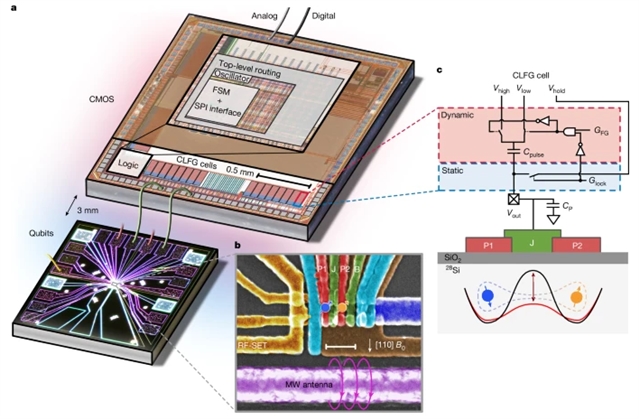
澳大利亚悉尼大学David J. Reilly团队实现了用毫开尔文CMOS芯片控制自旋量子位。这一研究成果发表在2025年6月25日出版的《自然》杂志上。
自旋量子比特的一个关键优点是它们的亚微米足迹,使单个硅芯片能够承载执行具有纠错功能的有用量子算法所需的数百万个量子比特。然而,由于每个物理量子位都需要多条控制线,因此扩展的一个基本障碍是将量子设备连接到其外部控制和读出硬件的极端连接密度。一个有前景的解决方案是在毫开尔文温度下将控制系统与量子比特平台近端共置,通过小型化互连连接。即便如此,来自紧密集成控制的热量和串扰仍有可能降低量子比特的性能,特别是对于基于交换耦合的双量子比特纠缠门,它们对电噪声很敏感。
研究组对硅金属氧化物半导体(MOS)风格的电子自旋量子位进行基准测试,这些量子位由异质集成低温互补金属氧化物半导体电路(低温CMOS)控制,其功率密度足够低,可以实现放大。为了证明低温CMOS可以有效地执行自旋量子比特的通用逻辑运算,研究组继续证明毫开尔文控制对单量子比特和双量子比特门的性能影响很小。考虑到该亚开尔文CMOS平台的复杂性,大约有100000个晶体管,这些结果为基于自旋量子位与“小芯片式”控制架构的紧密封装的可扩展控制开辟了前景。
附:英文原文
Title: Spin-qubit control with a milli-kelvin CMOS chip
Author: Bartee, Samuel K., Gilbert, Will, Zuo, Kun, Das, Kushal, Tanttu, Tuomo, Yang, Chih Hwan, Dumoulin Stuyck, Nard, Pauka, Sebastian J., Su, Rocky Y., Lim, Wee Han, Serrano, Santiago, Escott, Christopher C., Hudson, Fay E., Itoh, Kohei M., Laucht, Arne, Dzurak, Andrew S., Reilly, David J.
Issue&Volume: 2025-06-25
Abstract: A key virtue of spin qubits is their sub-micron footprint, enabling a single silicon chip to host the millions of qubits required to execute useful quantum algorithms with error correction1,2,3. However, with each physical qubit needing multiple control lines, a fundamental barrier to scale is the extreme density of connections that bridge quantum devices to their external control and readout hardware4,5,6. A promising solution is to co-locate the control system proximal to the qubit platform at milli-kelvin temperatures, wired up by miniaturized interconnects7,8,9,10. Even so, heat and crosstalk from closely integrated control have the potential to degrade qubit performance, particularly for two-qubit entangling gates based on exchange coupling that are sensitive to electrical noise11,12. Here we benchmark silicon metal-oxide-semiconductor (MOS)-style electron spin qubits controlled by heterogeneously integrated cryo-complementary metal-oxide-semiconductor (cryo-CMOS) circuits with a power density sufficiently low to enable scale-up. Demonstrating that cryo-CMOS can efficiently perform universal logic operations for spin qubits, we go on to show that milli-kelvin control has little impact on the performance of single- and two-qubit gates. Given the complexity of our sub-kelvin CMOS platform, with about 100,000 transistors, these results open the prospect of scalable control based on the tight packaging of spin qubits with a ‘chiplet-style’ control architecture.
DOI: 10.1038/s41586-025-09157-x
Source: https://www.nature.com/articles/s41586-025-09157-x
Nature:《自然》,创刊于1869年。隶属于施普林格·自然出版集团,最新IF:69.504
官方网址:http://www.nature.com/
投稿链接:http://www.nature.com/authors/submit_manuscript.html
